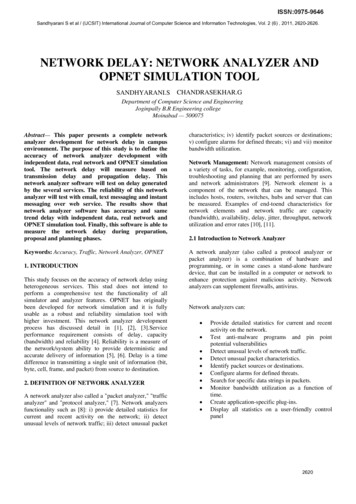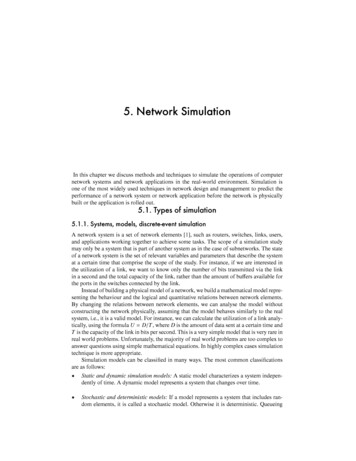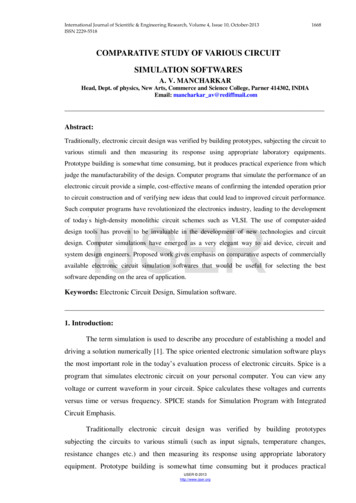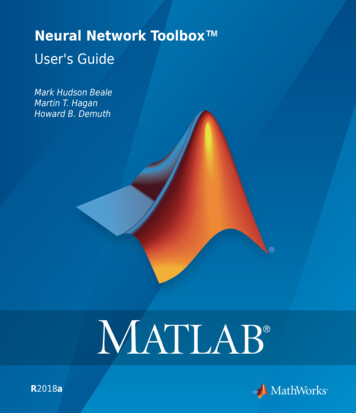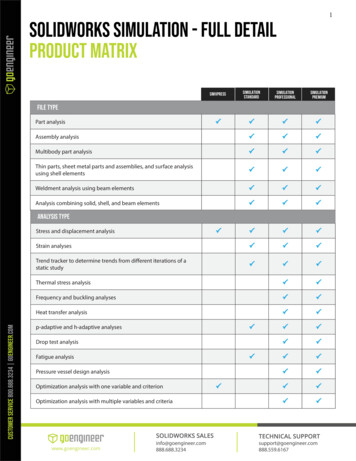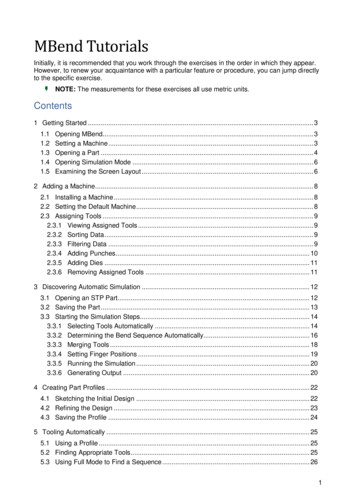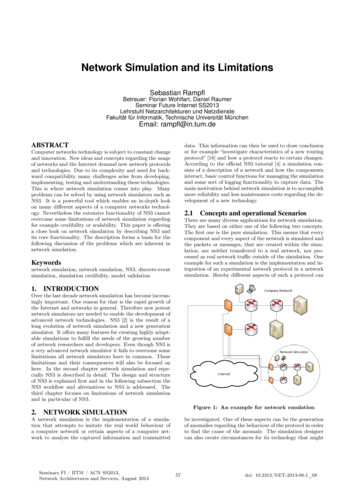
Transcription
Network Simulation and its LimitationsSebastian RampflBetreuer: Florian Wohlfart, Daniel RaumerSeminar Future Internet SS2013Lehrstuhl Netzarchitekturen und NetzdiensteFakultät für Informatik, Technische Universität MünchenEmail: rampfl@in.tum.deABSTRACTdata. This information can then be used to draw conclusionor for example “investigate characteristics of a new routingprotocol” [18] and how a protocol reacts to certain changes.According to the official NS3 tutorial [4] a simulation consists of a description of a network and how the componentsinteract, basic control functions for managing the simulationand some sort of logging functionality to capture data. Themain motivation behind network simulation is to accomplishmore reliability and less maintenance costs regarding the development of a new technology.Computer networks technology is subject to constant changeand innovation. New ideas and concepts regarding the usageof networks and the Internet demand new network protocolsand technologies. Due to its complexity and need for backward compatibility many challenges arise from developing,implementing, testing and understanding these technologies.This is where network simulation comes into play. Manyproblems can be solved by using network simulators such asNS3. It is a powerful tool which enables an in-depth lookon many different aspects of a computer networks technology. Nevertheless the extensive functionality of NS3 cannotovercome some limitations of network simulation regardingfor example credibility or scalability. This paper is offeringa close look on network simulation by describing NS3 andits core functionality. The description forms a basis for thefollowing discussion of the problems which are inherent innetwork simulation.2.1Keywordsnetwork simulation, network emulation, NS3, discrete-eventsimulation, simulation credibility, model validation1.Concepts and operational ScenariosThere are many diverse applications for network simulation.They are based on either one of the following two concepts.The first one is the pure simulation. This means that everycomponent and every aspect of the network is simulated andthe packets or messages, that are created within the simulation, are neither transferred to a real network, nor processed as real network traffic outside of the simulation. Oneexample for such a simulation is the implementation and integration of an experimental network protocol in a networksimulation. Hereby different aspects of such a protocol canINTRODUCTIONOver the last decade network simulation has become increasingly important. One reason for that is the rapid growth ofthe Internet and networks in general. Therefore new potentnetwork simulators are needed to enable the development ofadvanced network technologies. NS3 [2] is the result of along evolution of network simulation and a new generationsimulator. It offers many features for creating highly adaptable simulations to fulfill the needs of the growing numberof network researchers and developers. Even though NS3 isa very advanced network simulator it fails to overcome somelimitations all network simulators have in common. Theselimitations and their consequences will also be focused onhere. In the second chapter network simulation and especially NS3 is described in detail. The design and structureof NS3 is explained first and in the following subsection theNS3 workflow and alternatives to NS3 is addressed. Thethird chapter focuses on limitations of network simulationand in particular of NS3.2.Figure 1: An example for network emulationNETWORK SIMULATIONbe investigated. One of these aspects can be the generationof anomalies regarding the behaviour of the protocol in orderto find the cause of the anomaly. The simulation designercan also create circumstances for its technology that mightA network simulation is the implementation of a simulation that attempts to imitate the real world behaviour ofa computer network or certain aspects of a computer network to analyse the captured information and transmittedSeminars FI / IITM / ACN SS2013,Network Architectures and Services, August 201357doi: 10.2313/NET-2013-08-1 08
not be possible on a real world testbeds. One application ofthis may be the creation of a simulation with connectionsof higher bandwidths than today’s networks are capable of.This makes it possible to investigate the behaviour of theprotocol under circumstances which might occur in the future. Another application for network simulation is the newresearch field of car-to-car networks, which is very costly andeven risky when implementing prototypes and testing them.The second concept is network emulation. Simulators canbe combined with and attached to real networks to send andreceive traffic of these networks. The Figure 1 visualizes anidea on how to use network emulation to help defend againsta Distributed-Denial-of-Service attack. A company networkis connected to the Internet and guarded by firewalls. Thesefirewalls are also connected to a network simulation andare able to mirror every traffic that passes through them.This simulation tries to copy the topology, attributes andbehaviour of the company network. In case of a DDoS attack the firewalls could forward the traffic to the simulationand a load balancing software could apply different loadbalancing strategies by reconfiguring the emulated network.Furthermore it would use the results of its tests to make adecision on what load-balancing strategy may be the mosteffective against the ongoing attack. This strategy can thenbe applied to the real company network in order to repel theattack. This is obviously are highly complex and elaborateway of using network emulation, but it demonstrates, thatthere are more fields of application for network simulatorsthan research and development.reason for redesigning the simulator was the “limited scalability regarding memory usage and runtime” as describedin [18] . NS2 was designed to reduce compilation time byusing C in combination with the scripting language oTcl.While the simulation components, their behaviour and thetopologies are described by C code, oTcl scripts modelthe overall simulation behaviour and are used for binding.Today’s simulation designers are not focused on compilationtime, but on scalability and performance. This led to thedevelopment of NS3. The following subsections describesthe functionality NS3 offers and explains how to work withit.2.2.1Figure 2: The cycle of network simulation [16]The development of a technology or a product with the helpof network simulation is an iterative process. As drafted infigure 2 a simulation is modelled on the ideas and conceptsof the simulation designer. The results and measurementsof the simulation are used to alter it, in order to createdifferent simulation behaviour and results, until the desiredoutcome can be accomplished. In comparison to implementing a protocol on a real testbed simulation is in most casesmore flexible and less cost-intensive. Even though creatinga simulation may also become elaborate and costly.2.2NS3NS3 is a discrete-event network simulator. It is open sourceand licensed under the GNU GPLv2 license. Since its release in 2008 it is one of the most important and widelyused network simulation tools. Even though it does notoffer any graphical user interface it has proven to be comprehensible and easy to handle. NS3 is intended to be usedwith Linux, although it is possible to run it on Windows byusing cygwin or MiniGW. It was developed to replace itspredecessor NS2, which was released in the mid-90s. TheSeminars FI / IITM / ACN SS2013,Network Architectures and Services, August 2013Design and StructureAs stated before NS3 is based on the concept of discretesimulation. This means that a point in simulation time isassigned to every event, events are initiated and triggeredconsecutively and “simulation time moves in discrete jumpsfrom event to event”[8]. Computing these events in realtime is an option as long as the system running NS3 offersenough computing power and the attributes set for the simulated network do not exceed the laws of physics. Especiallyin network emulation this may become necessary when sending or receiving packets from real world hosts. In most caseshowever realtime is not an issue and the focus is more on theorder of events and their consequences regarding captureddata.The NS3 project uses Mercurial [10] for source code management. Documentation of this code can be accessed via Doxygen [17], a tool for creating documentation. The Pythonbased build system waf [7] is recommended by the NS3 development team. Their NS3-tutorial [4] gives all necessaryinformation for getting started with NS3. This documentis also a step-by-step documentation of a couple of usefulimplementation examples for some network simulations.Creating a NS3 simulation consists of four basic steps. Before describing them in detail the key abstractions of a NS3simulation have to be explained. These basic componenttypes of a network are nodes, applications, net devices, channels and topology helpers. They are all represented by setsof C classes and their functions and properties, includingexamples, are explained in the ns3-tutorial [4]. A node in aNS3 simulation stands for a communication point, such asan end system or a router. It is the base for any events andinteraction. Functionality and properties are added to thesenodes. The nodes are interconnected by channels, whichrepresent the different forms and media of data transmission. Two of the C classes in NS3 that describe channels are the PointToPointChannel and the WifiChannel. Asthe name indicates the PointToPointChannel implements asimple wired connection from one endpoint to another endpoint. The WifiChannel represents a Wifi connection andis designed to behave like such a connection. The third keyabstraction are net devices. They are attached to nodes andchannels and form what in real world would be considerednetwork interfaces. There are different types of net devicesdue to the diversity of channels. As in a real network a nodecan be attached to multiple net devices. The application isanother key abstraction of every NS3 simulation. It formsthe actual functionality of the nodes and is supposed to beimplemented by the simulation designer. NS3 offers manydifferent applications for all kinds of network functionality.Configuration and adaptation of these applications is the key58doi: 10.2313/NET-2013-08-1 08
to creating the intended network behaviour. The main functionality of the applications is the creation, processing andtransmission of data. The simulation designer can createand configure nodes, channels, net devices and applicationsseparately or this can be done by using the extensive andpowerful Helper-API of NS3. These helper classes make itpossible to configure a network simulation with relativelylow effort. Adding a protocol stack and addresses to a set ofnodes are one of the many options the helper classes offer.They also make it much easier to read and understand thecode of an NS3 simulation. As mentioned before all codeis documented and can be accessed via Doxygen. Having acloser look on what the NS3 helper have to offer is recommend before starting to program a simulation.Figure 3 the simulator offers trace sources and the simulationdesigner implements the trace sinks. These trace sinks specify what information to capture an what to ignore. Tracingcan be used on different levels of abstraction. The designercan either use preconfigured sets of trace sinks with less adjustment capabilities or specify trace sinks in detail. Toolittle or too much information can destroy the benefit of implementing a simulation and therefore much considerationshould be given to tracing in NS3. Filtering information isone key for success, because insufficient information leads towrong conclusions regarding the simulated network.2.2.2 NS3 WorkflowThe helper classes are a main aspect of the NS3 workflow. Asmentioned in chapter 2.2.1 there are four main steps whenworking with NS3. The first one is the programming of theactual network with its topology, the used protocols and itsapplications. This is done by the abovementioned helpersand can be illustrated with the following example. In orderto create a group of hosts a NodeContainer class is initiated with the corresponding attributes such as the numberof hosts. Furthermore the InternetStackHelper class is usedto add the network protocol stack to the nodes in order toenable Internet communication. The first step also includessetting up all addresses, such as MAC and IP addresses, andadding and writing the application classes. This is wheremost of the logic is implemented. Another important partis the configuration of the class attributes. NS3 offers anattribute system, which enables a more convenient way ofdealing with properties, variable values and other simulation related information. As described in [8] namespacesFigure 4: GUI of NetAnim visualization tool [14]After programming the simulation in step one and two thenext stage is the execution of the simulation.The fourth step is the output analysis. This not a part ofNS3, but an important aspect of network simulation. NS3offers no tools for analyzing, visualizing or processing thedata gained through network simulation. Nevertheless thereare many free tools offering a broad range of features for thispurpose. One of them is NetAnim [14]. It is a tool to animate data gained from tracing. Figure 4 is a screenshotof the GUI of NetAnim. Another tool for visualization isFigure 3: Tracing Sources and Sinksand paths can be used to access and edit the values and information the attributes offer. A list and description of allattributes can be found in the official attributes manual [3].The second step is the description of the simulation behaviour. A set of methods for initiating and stopping thesimulation, as well as other control methods such as debuglogging needs to be included in the implementation of thesimulation. Tracing has be configured too. As depicted inSeminars FI / IITM / ACN SS2013,Network Architectures and Services, August 2013Figure 5: Gnuplot graph visualizing simulator output [18]Gnuplot [19]. With Gnuplot static, highly customizable 2Dand 3D graphs can be created to visualize large amounts ofdata. Figure 5 displays a Gnuplot graph. This 3D graph59doi: 10.2313/NET-2013-08-1 08
visualizes the amount of packet-loss observed in a networksimulator performance comparison carried out in the reference [18]. Wireshark is also a useful tool in this context. Itspurpose is filtering and displaying transmitted informationby listing packets and its content. All these tools for outputanalysis offer a broad range of options and customizabilityand this is a necessity in the field of network simulation.where every output analysis needs to focus on very specificinformation and goals.derstandability regarding the complexity of a network simulation. These two aspects are very important for companieswhen choosing a network simulator for the development oftheir network technologies.2.2.3 ModelsModels are a key element of NS3. In the NS3 model library[5] models are defined as “abstract representations of realworld objects, protocols, devices, etc.” [5] or as stated in[4] “an abstraction of reality” . Models are written in C and are aggregated into modules, which are all individualsoftware libraries. NS3 relies on an active community. Itdesigns, implements, documents, tests and validates thesemodels. The models are meant to form the base for simulation designers to create the functionality they have in mind.The behaviour of these models can be modified by changing the code, adding new attributes or just reconfiguringthe attributes. The abovementioned helper classes provideeasy access to the models. The NS3 model library [5] listsa large variety of models. Some of them implement relatively simple functionality such as the Point-to-Point modeland others offer more complex functionality such as local orglobal routing protocols. A model needs to be validated inorder to know whether and to what extent the model differsfrom the behaviour of real world object it is trying to simulate. This topic will be discussed in a chapter 3.1.NS3 frameworks are groups of models, which focus on modeling coherent functionality. A framework is intended to offera simulation of an environment, which simulation designerscan build upon. An example for this is the UAN Framework[5]. It offers a variety of underwater network scenarios.The NS3 predecessor NS2 also relies on the concept ofcommunity-based model development, but NS2 models arenot compatible to NS3. This means that, even though NS2models also written in C , integrating them into a NS3simulation is not possible without extensive adjustments.With the amount of available models constantly growingthis concept has proven to be quite powerful.2.3Figure 6: Different levels of the OPNET graphicaluser interface [12]A second alternative is SimPy [11], a Python based opensource network simulator. It is licensed under the GNULesser GPL, which means it is free for non-commercial use.SimPy is a “object-oriented, process-based discrete-event”simulator [11] and written in Python. It offers a GUI andeven plotting for output data. The developers claim SimPyto be and very easy to use network simulator. SimPy seemsto be a good alternative for those who want to work witha GUI when designing a simulation and are not willing toinvest in a proprietary software system.Alternatives to NS33.There are several network simulators with slightly different approaches regarding modeling of simulations, revenuemodel and support. One of them is OPNet. In contrastto NS3 OPNet [12] is a commercial network simulator. Itoffers a graphical GUI for the design of the simulation andthe visualization of captured data for output analysis. LikeNS3 OPNet simulations are based on discrete events. Onedisadvantage of OPNet is the fact that it is proprietary software and therefore limited in terms of customizability. LikeNS3 an open source system can be modified in every aspectand the OPNet simulator lacks that feature. Another disadvantage is the lack of support and collaboration an activecommunity of an open source project provides. NeverthelessOPNet has gained a big market share. Two reason for thisare the fact that it has the resources to offer customer support and validation of their models. Another aspect is thegraphical user interface. Figure 6 displays different levels ofthe OPNet GUI. Such a bundle of features increases the un-Seminars FI / IITM / ACN SS2013,Network Architectures and Services, August 2013LIMITATIONS OF NS3As stated and described in chapter two network simulationis a powerful tool for a range of possible applications. Nevertheless there are limitations to it. The history of network simulation is long and there has been many obstaclesin its evolution. Although constantly increasing computing power and more powerful programming languages managed to overcome many obstacles, some of them still remain.The different network simulators use different approacheson dealing with these limitations and therefore their performance and reliability vary. This chapter focuses on thelimitations of NS3, as well as its consequences.3.1Credibility and ValidationSimulation credibility is a challenge not only in the field ofnetwork simulation. All aspects of reality can never be implemented in a simulation and therefore compromises have60doi: 10.2313/NET-2013-08-1 08
to be made. Such compromise can be a lower level of simulation detail or the absence of certain aspects of the network.A network simulation can only be useful if the behaviour itshows and the results it delivers are comparable to a realnetwork. The simulation designer can never be one-hundredpercent sure if this is the case. Hence a certain level of trustis need when working with simulation.The authors of reference [8] name three strategies to increasetrust in a simulation. The first two are the rather simple concepts of regression tests and reuse of code. These methodsare useful in case of fault prevention and quality of code andtherefore have an indirect impact on the increase in credibility. The third strategy is the validation of models, inthis case the NS3 models described in the last main chapter, by using testbeds. The main purpose of a validation isto proof, that the behaviour of a network simulation modelis comparable to the behaviour of a testbed with the sameconfiguration as the simulated network. This is needed bysimulation designers who want to use these models to createnew simulations, because they are relying on the correctnessof these models. The Reference [1] is such a validation. Theauthors of [1] are comparing the performance and behaviourof the IEEE 802.11 MAC model of NS3 to a testbed providing the same functionality. Furthermore they draw conclusion from their results. Therefore they use different scenarioswith different focuses and objectives and then compare theirmeasurements. They come to the conclusion that the IEEE802.11 MAC model is a rather good representation of reality,although the authors observed some “noticeable quantitativedifferences” [1] regarding the measurements. In their opinion this is not necessarily the fault of the model but mayalso be a flaw in the implementation of the testbed. Theconclusion of the authors demonstrates another problem regarding the credibility of network simulation models. Evenif the model someone is trying to validate is flawless in termsof behaviour and attributes, the testbed with its real worldhardware and implementations is probably not. Thereby theresults of measurements may differ significantly. Simulationdesigner always have to consider that they are creating asimulation to estimate the real world behaviour of the network technology and do not want to create a perfect simulation implementation. In summary it can be said, therefore,that validation is a potent method to build up credibility, ifthe fact, that real world devices not always behave like theyshould be, is considered.3.2likely the occurrence of these problems becomes. None ofthe sources describes any solution to this problem.3.3Scalability LimitsOne of the benefits of simulating a network is the fact thatadding or removing components, devices and channels iseasy and fast in comparison to a testbed where devices haveto be installed and connected. A simulation is in theorynot limited by the amount of devices or transmitted data.In reference [6] the topic of network simulation scalabilityis covered by “quantitatively [characterizing] the capabilityof parallel simulation tools to simulate large-scale networks”.The authors identify two main limiting factors for scalabilityof network simulators: the memory usage and the requiredcomputation time. Every node, channel and the other components require memory space and therefore their number islimited by the available memory. As in a discrete event simulator, such as NS3, events are processed in a certain timeand the amount of events that can be processed is limitedassuming that the simulation designer defines a maximumtime for the computation of the simulation.The authors of [6] explain how to improve simulation scalability. Their approach is the usage of parallel computing forprocessing events. Although this paper is ten years old andhence references to NS2, the main concept of parallel computation of network simulations is applicable to NS3. TheNS3 model library [5] describes how to integrate the MessagePassing Interface [9] in a NS3 simulation. MPI is a standardwhich formulates rules for the parallelization of programs regarding the exchange of information. Its purpose is to enablehigh performance computing on large clusters of processors.In addition to parallelization the use of distributed networksimulation can improve simulation performance and therefore alleviate scalability problems. This concept describesthe usage of multiple network simulators deployed on geographically distributed machines. In contrast to the parallelexecution of one network simulation on a high performancecomputation center a distributed simulation needs to focusmore on reducing the amount of information sent betweenthe distributed network simulators in order to increase simulation performance. The authors of [15] describe two different methods to split up the functionality of simulateddevices.Simulation of upper Layer FunctionalityAs described in chapter 2.2.3 simulation designers do notbuild up all functionality from scratch. They rely heavilyon the usage of models. Every model, even if validated,are a possible source of wrong behaviour and failure. Validation is an improvement, but it does not guarantees theabsence of malfunction or the presence of all expected features. The designer always has to consider what a modeldoes not implement. It may be written for one context inwhich it functions flawlessly, but, if used in a different context, malfunctions completely. The problem of overratingthe capabilities of models is described in [4]. Some models implement every component of a network protocol, butthis does not mean that every aspect of its behaviour doesnot differ from how the protocol would behave in the realworld given the same preconditions and circumstances. Thehigher in the protocol stack the designer operates the moreSeminars FI / IITM / ACN SS2013,Network Architectures and Services, August 2013Figure 7: Cross-protocol stack method [15]The first one is the cross-protocol stack method. The mainconcept behind it is the computation of complete devicesor groups of devices of the simulated network on only onenetwork simulator. This means that the network stack of61doi: 10.2313/NET-2013-08-1 08
one simulated device is located at only one network simulator. Therefore only messages sent from devices withinthe simulation are exchanged between the distributed network simulators. Figure 7 visualizes this concept. Contraryto the cross-protocol stack method the split-protocol stackmethod distributes the different layers of the protocol stackto different network simulators. In this case the information exchanged between the network simulators are not themessages sent between the simulated devices but the information passed through the different layers of the protocolstack. One simple example for this is shown in figure 8.The effect of both methods on the amount of message sentbetween the distributed network simulators highly dependson the topology and the functionality implemented in thesimulation [15].of the human mind in terms of the ability to deal with highcomplexity results than a limitation for network simulation.Some measures regarding structured planning of simulationsand a more formalized documentation of models may helpreduce this problemScalability also remains to be an obstacle. However in contrast to credibility this problem is alleviated to some degree.Real world networks do not grow as fast as the networks thatcan be simulated. The Internet may be highly complex andnot well understood, but progress is being made and therefore scalability may become less of a limitation than it usedto be.5.Figure 8: Split-protocol stack method [15]Reference [13] is a performance analysis of a NS3 networksimulation using the abovementioned MPI model to establish distributed and parallel computation. Their results leadthe authors to the conclusion that “nearly optimal linearspeedup is achievable”[13]. Parallelization and the distribution of network simulation are effective approaches for increasing scalability, but fail to overcome the following aspectof scalability. Often simulation designers want to test theirnetwork technology in an Internet-like environment. This isbarely possible due to its size and complexity. As claimedin [6] the reason for this is the fact that the Internet is notunderstood very well and therefore hard to simulate. Thisis not exclusively a scalability problem but it is a limitationto network simulation.4.CONCLUSIONWith being easily accessible and at the same time highly customizable NS3 has proven to be a potent network simulator.The combination of helper classes and the option to configure the classes individually turned out to be a very usefulconcept. The community-based model concept of NS3 is astrong point and a disadvantage at the same time. The factthat NS3 is a non-commercial software results in a larger andtherefore more active community, which constantly helps toimprove, extend and upgrade NS3. On the other hand thismakes it impossible to guarantee reliable customer supportand bug fixes. This gap is successfully filled by competitorssuch as OPNet.There are of course some limitations to network simulationthat even NS3 cannot overcome. One of them is credibility.This will always be an issue, because it is clearly impossibleto guarantee flawless real world behaviour of a simulation.One approach to partially solve this problem could be a farmore detailed formalization of the validation process.The limitation regarding upper layer functionality is in comparison to validation rather simple. It is more of a limitationSeminars FI / IITM / ACN SS2013,Network Architectures and Services, August 2013REFERENCES[1] Nicola Baldo, Manuel Requena, Jose Nunez, MarcPortoles, Jaume Nin, Paolo Dini, and Josep Mangues.Validation of the ns-3 ieee 802.11 model using theextreme testbed. In Proceedings of SIMUToolsConference, 2010, March 2010.[2] NS-3 development team. Ns-3 network simulator.http://www.nsnam.org/.[3] NS-3 development team. Ns-3 network simulator, ns-3attributes. /attributes.html.[4] NS-3 development team. Ns-3 network simulator, ns-3tutorial, Decenmber 2012. -3-tutorial.pdf.[5] NS-3 development team. Ns-3 network simulator, ns-3m
network simulation, network emulation, NS3, discrete-event simulation, simulation credibility, model validation 1. INTRODUCTION Over the last decade network simulation has become increas-ingly important. One reason for that is the rapid growth of the Internet and networks in general. Therefore new potent

